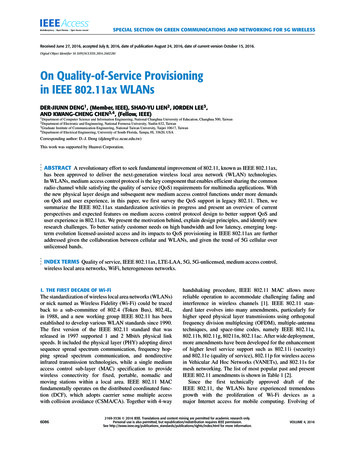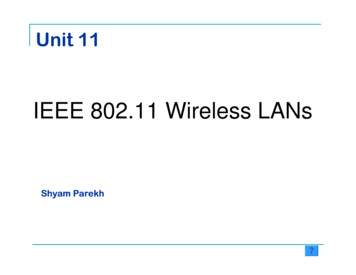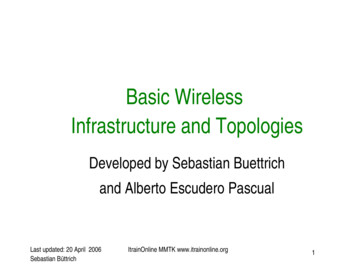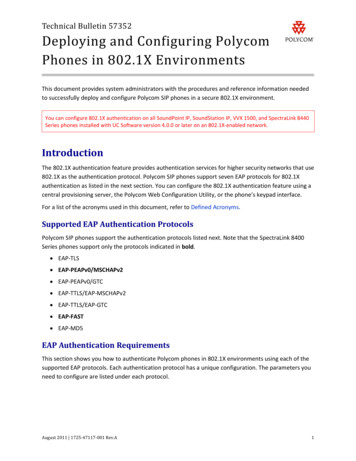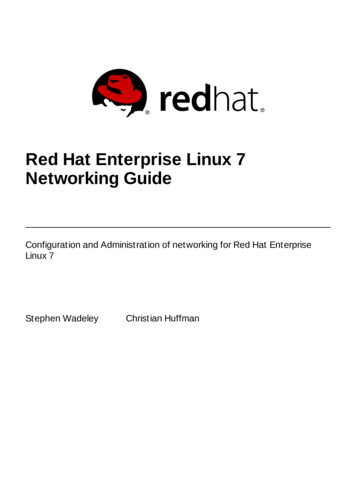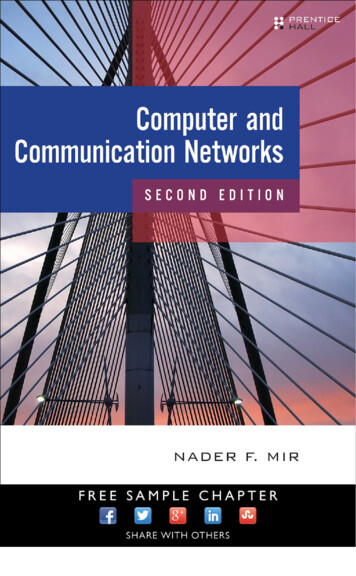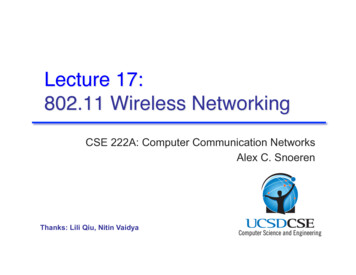
Transcription
Lecture 17:802.11 Wireless Networking"CSE 222A: Computer Communication NetworksAlex C. SnoerenThanks: Lili Qiu, Nitin Vaidya
Lecture 17 Overview" Project discussion Intro to 802.11 WiFi Jigsaw discussionCSE 222A – Lecture 17: Wireless Networking"2
Project update" Second checkpoint due Thursday 1-2 page summary of your progress since last checkpointProject presentations Tuesday 3/19 Sign up for a 25-minute slot between 8am and 2:30pm» 20 minute presentation (including all project members)» 3-4 minutes for questions You will be expected to attend at least 5 presentations andactively participate in discussionReports due Thursday 3/21 by midnightCSE 222A – Lecture 17: Wireless Networking"3
Infrastructure vs. Ad hoc"infrastructurenetworkAPAPwired networkAP: Access PointAPad-hoc networkCSE 222A – Lecture 17: Wireless Networking"4
IEEE 802.11 Infrastructure"mobile ionTCPTCPaccess pointIPLLCapplicationIPLLCLLC802.11 MAC802.11 MAC802.3 MAC802.3 MAC802.11 PHY802.11 PHY802.3 PHY802.3 PHYCSE 222A – Lecture 17: Wireless Networking"5
802.11 - Layers and functions" MAC access mechanisms,fragmentation, error control,encryption MAC Management PLCP Physical Layer Convergence ProtocolPMD Physical Medium Dependent synchronization, roaming, MIB,power management MACMAC ManagementPLCPPHY ManagementPMDCSE 222A – Lecture 17: Wireless Networking"Station ManagementDLCPHYLLCmodulation, codingPHY Management clear channel assessment signal(carrier sense)channel selection, MIBStation Management coordination of all managementfunctions6
802.11 Physical Layers "" 802.11b - 2.4 GHz ISM band 802.11a/g - 2.4 GHz ISM band / 5.0 GHz UNII band OFDM (Orthogonal frequency domain multiplexing)Up to 54 Mbps802.11n – 2.4/5.0 GHz bands FHSS (Frequency hopping spread spectrum); deprecatedDSSS (Direct sequence spread spectrum)Up to 11 MbpsAdds MIMO and other tricks to 802.11gUp to 300-500 Mbps!Each backwards compatible with the previous onesCSE 222A – Lecture 17: Wireless Networking"7
IEEE 802.11b" Data rate Transmission range 1, 2, 5.5, 11 Mbit/sUser data rate max. approx. 6 Mbit/s300m outdoor, 30m indoorMax. data rate 10m indoorFrequency Free 2.4 GHz ISM-bandCSE 222A – Lecture 17: Wireless Networking"8
802.11b Physical Channels" 12 channels available for use in the US Each channel is 20 2 MHz wideOnly 3 orthogonal channelsUsing any others causes interferenceUS (FCC)/Canada (IC)channel 124002412channel 6channel 112437246222 MHzCSE 222A – Lecture 17: Wireless Networking"2483.5[MHz]9
Motivation for multicarrier modulationMultipath Interference" RF signals bounce off of objects (e.g., walls)Reflected signals travel different distances to receiver Difference in distance leads to difference in delay AirTight NetworksLimits effective modulationrate in 802.11bCSE 222A – Lecture 17: Wireless Networking"10
Orthogonal frequency divisionAvoidingmultiplexingISI: OFDM"(OFDM) Break data up into multiple separate streams Transmit each stream independently on different frequency Pack frequencies so that they are orthogonalCSE 222A – Lecture 17: Wireless Networking"AirTight Networks11
OFDM in 802.11802.11a/g/nODFM PHY" Each 20-MHz channel divided into 50 subcarriers Subcarriers spaced appropriately, 4 used as “pilots” AirTight NetworksCSE 222A – Lecture 17: Wireless Networking"12
802.11n: MIMO" Use multiple physical antennae simultaneously Spatial multiplexing: split data cross antennaeSpace-Time Block Coding: same data, encoded differentlyTransmit beamforming: steer the signal toward the receiverCSE 222A – Lecture 17: Wireless Networking"13
Carrier Sense Multiple Access"CSMA: listen before transmit If channel sensed idle: transmit entire packet If channel sensed busy, defer transmission Persistent CSMA: retry immediately withprobability p when channel becomes idle (maycause instability)Non-persistent CSMA: retry after random intervalBut what about collisions?CSE 222A – Lecture 17: Wireless Networking"14
CSMA/CA" Impossible to hear collision w/half-duplex radioWireless MAC protocols often use collisionavoidance techniques, in conjunction with a(physical or virtual) carrier sense mechanismCollision avoidance Nodes negotiate to reserve the channel.Once channel becomes idle, the node waits for arandomly chosen duration before attempting totransmit.CSE 222A – Lecture 17: Wireless Networking"15
Hidden Terminal Problem"A CB can communicate with both A and CA and C cannot hear each otherProblem BWhen A transmits to B, C cannot detect the transmissionusing the carrier sense mechanismIf C transmits, collision will occur at node BSolution Hidden sender C needs to deferCSE 222A – Lecture 17: Wireless Networking"16
RTS/CTS (MACA)"A BCWhen A wants to send a packet to B, A first sends aRequest-to-Send (RTS) to BOn receiving RTS, B responds by sending Clear-toSend (CTS), provided that A is able to receive thepacketWhen C overhears a CTS, it keeps quiet for theduration of the transfer Transfer duration is included in both RTS and CTSCSE 222A – Lecture 17: Wireless Networking"17
Backoff Interval " Problem: With many contending nodes, RTSpackets will frequently collideSolution: When transmitting a packet, choose abackoff interval in the range [0, CW] Wait the length of the interval when medium is idle CW is contention windowCount-down is suspended if medium becomes busyTransmit when backoff interval reaches 0Need to adjust CW as contention variesCSE 222A – Lecture 17: Wireless Networking"18
MILD Algorithm in MACAW" MACAW uses exponential increase lineardecrease to update CW When a node successfully completes a transfer,reduces CW by 1In 802.11 CW is restored to CWminIn 802.11, CW reduces much faster than itincreasesMACAW can avoid wild oscillations of CWwhen many nodes contend for the channelCSE 222A – Lecture 17: Wireless Networking"19
Cute Hack" We can use CTS to reserve the channel for ourselves Doesn’t solve hidden terminal, but does squelch Means stations don’t need to be able to decode data frame802.11g uses CTS-to-self to operate w/802.11b Don’t use RTS/CTS handshake, just back halfCalled a CTS-to-self, simply transmit CTS before our packet11g stations always send a CTS before sending packetsencoded in a way (ODFM) that 11b stations can’t decodeMuch more efficient than full RTS/CTSCSE 222A – Lecture 17: Wireless Networking"20
Challenge: Reliability" Wireless links are prone to errors. High packet lossrate detrimental to transport-layer performance.Mechanisms needed to reduce packet loss rateexperienced by upper layersCSE 222A – Lecture 17: Wireless Networking"21
Link-layer ARQ" When B receives a data packet from A, B sends anAcknowledgement (ACK) to A.If node A fails to receive an ACK, it will retransmit thepacketABCSE 222A – Lecture 17: Wireless Networking"C22
Non-symmetric ranges"Carrier t “range”CSE 222A – Lecture 17: Wireless Networking"23
Other MACAW Features" Fairness: Normally, each node wins the channel withequal probability Conservative collision avoidance Nodes with multiple streams should be more aggressiveAbandoned in 802.11. Why?Use a Data Sending (DS) packet to reserve the channel802.11 uses different length intervals and the NAVRequest-for-Request-to-Send Assume carrier sense range far larger than transmissionrangeCSE 222A – Lecture 17: Wireless Networking"24
802.11 - MAC management" Association/Reassociation integration into a LANroaming, i.e. change networks by changing accesspointsscanning, i.e. active search for a networkPower management sleep-mode without missing a messageperiodic sleep, frame buffering, traffic measurementsCSE 222A – Lecture 17: Wireless Networking"25
Scanning" Goal: Find a network to connectPassive scanning Not require transmissionMove to each channel, and listen for BeaconframesActive scanning Require transmissionMove to each channel, and send Probe Requestframes to solicit Probe Responses from a networkCSE 222A – Lecture 17: Wireless Networking"26
Association in 802.11"1: Association request2: Association response3: Data trafficClientCSE 222A – Lecture 17: Wireless Networking"AP27
Reassociation in 802.11"1: Reassociation request3: Reassociation response5: Send buffered framesClient6: Data trafficNew AP2: verifypreviousassociationOld APCSE 222A – Lecture 17: Wireless Networking"4: sendbuffered28frames
For Next Class " Read and review ExOR paper Keep going on projects! Checkpoint 2 due ThursdayCSE 222A – Lecture 17: Wireless Networking"29
Wireless MAC protocols often use collision avoidance techniques, in conjunction with a (physical or virtual) carrier sense mechanism Collision avoidance Nodes negotiate to reserve the channel. Once cha

